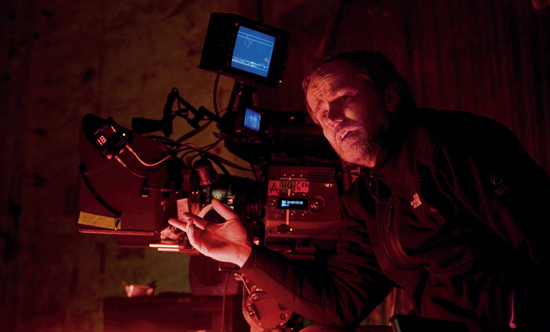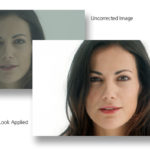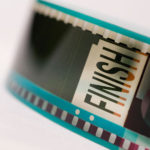
Harry Brown
Posted on Apr 30, 2010 by Alex Fice
When Sony announced the F35 camera at the end of 2007, there was a certain amount of surprise because their F23 ‘two thirds’ sensor camera hadn’t been out for long. Any disgruntlement from F23 owners was allayed by some preferential upgrade deals. But that’s all forgotten now as the F35 starts producing the movies it was created for (DoP Martin Rühe and Michael Caine in Harry Brown)
“Designed to go to the bottom of the ocean and to the tops of the highest mountains” was how the Sony F35 was described at a press launch event near the end of 2007. The camera wouldn’t be available until the following Autumn but the very fact that Sony finally had a camera to compete specifically with 35mm film was special enough for the assembled hacks. Most people seem to take for granted that Sony products work in those extreme places mentioned – at that time, back in 2007, the statement was seen as a comparison with the RED camera which was known to have had problems in hotter weather and at the time was unproven technology, but since then at least we know that it loves the cold. (See HD Magazine issue 36 ‘Ghosts of the Exxon Valdez’).
London’s Take 2 Films received their Sony F35s earlier this year and quickly found takers for the new camera system, from a BBC drama production of Day Of The Triffids starring Dougray Scott, Joely Richardson, Brian Cox, Vanessa Redgrave, Eddie Izzard and Jason Priestley and a low budget movie called Harry Brown starring Hollywood legend Michael Caine.
Harry Brown
DoP for Harry Brown was Martin Rühe who had worked with the Director Daniel Barber before on a commercial, but on that occasion had used a Panavision Genesis camera. Apart from the previous relationship he was also interested in the new camera, liked the script and wanted to work with Caine. “I mostly have a film background. I’ve done a lot of commercials and music videos mostly on film and never worked with this camera before. I think we were the first in the UK to use the camera for a feature.
“For budget reasons it was clear we were always going to shoot in high definition rather than film so I tested the F35 against the Genesis, and the Arri D21. We found that the D21 didn’t have the sensitivity for night shoots but we found their Mscope very interesting. Its an anamorphic way of using the full HD chip in 2.35 but the sensitivity at night was just so bad we didn’t choose it in the end.
“The Genesis and the F35 quality-wise were very close to each other but the F35 was just a little bit better and gave us the option to use any lenses we wanted, so we chose Arri Master Primes, very light and sensitive lenses”.
The camera testing went all the way to Arri Laser printing emulation through Framestore’s Baselight suite and again the F35 proved to be the best option.
Sony Log Mode
Martin treated the F35 like film in as much as not wanting to delve in to the menus and start changing settings. “I wanted to keep as much information on to tape as possible so we shot in the Log mode which is like the RAW mode in digital stills. Also if I wanted any colour correction I would use filters and not the electronic menu, I kept it really quite pure in that sense.
 DoP Martin Rühe and his feature rigged Sony F35“We were shooting in the winter and at night and were using camera cars so I chose to record to SR tape as the most reliable way to go. The edit was also set up for tape and not hard drive recording.
DoP Martin Rühe and his feature rigged Sony F35“We were shooting in the winter and at night and were using camera cars so I chose to record to SR tape as the most reliable way to go. The edit was also set up for tape and not hard drive recording.
“The way we moved the camera was very much like a film shoot, but the advantage of this camera was that at night we used it with up to +6dB gain, so I rated it at 1000 ASA – with the Master Primes, which open up to 1.3, you don’t need a lot of light. If you light nights you always see where your set ends because that’s where your light ends. But we used so little light we could always blend in with the city environment, that was a really nice feature of it.
“It was complicated for my camera assistant to work with it because of the little depth of field, but I’m not sure we could have got that effect using film. But when people see the film I don’t think they will know if its film or HD and I think that’s a good thing.
“Sometimes the camera had issues with strobing where I wouldn’t expect it. It was when we were filming a TV screen for a Karaoke scene. We were just panning off it and and there was some weird interlacing that we couldn’t solve. There was also one issue we had with the SR tape recorder on the camera and we were talking to Sony about it because it would start recording a take, during the take it would go in to grey so there’s no information recorded, they couldn’t explain why that was happening.”
State Of HD Market
Martin admits that without the use of HD, Harry Brown might not have been made or would have been a completely different movie. As for the state of the HD camera market for movies, his experience is still limited: “This (Sony F35) is a good camera as is the Panavision Genesis which I have used a few times on commercials. It’s very good if you have a lot of post production because you immediately see if it works or not. I don’t think that HD has the quality of film, also we shot this film in 2.35 and the chip of the camera is 16×9 so to get to 2.35 you just crop the image – you’re left with less than HD resolution. That’s why we tried the Arri with the Mscope because you get to use the whole chip but it was just not good enough at night – we couldn’t use it. I think it would’ve been an alternative if we had shot day exterior or had more time and money for lighting but we didn’t.”
 Martin also look at using the Viper with its inherent 2.35 squeeze but realised that there just weren’t enough cameras in the UK to proceed. “I heard there wasn’t a lot of supply in the UK and we needed up to four cameras on some days, it was going to be a bit tight if we had used the Viper. That was also another reason not to go with Mscope because I don’t think we would have had enough anamorphic lenses for it. There was also a big cost factor.”
Martin also look at using the Viper with its inherent 2.35 squeeze but realised that there just weren’t enough cameras in the UK to proceed. “I heard there wasn’t a lot of supply in the UK and we needed up to four cameras on some days, it was going to be a bit tight if we had used the Viper. That was also another reason not to go with Mscope because I don’t think we would have had enough anamorphic lenses for it. There was also a big cost factor.”
Film To Digital
How is Martin changing his shooting style with digital cinematography? “I do shoot a little bit differently from the way I usually do, for example I use my light meter much less than I would with film, I watch the waveform monitor much more. That’s a good reference and sometimes you’re a bit surprised that even with very low light it looks quite good on the monitor. Most of the HD cameras except maybe the Arri don’t have very good viewfinders and that’s something that really throws me off because you look in to the eye piece of a Sony F35 and that looks very different from what you get to tape. The colour balance isn’t very good, the sharpness is very hard to judge. The Genesis is the same. Also we were shooting in very cold circumstances and the viewfinder steamed up very easily, film cameras have special tools to avoid those things.
“We graded on the Baselight and it worked out really well. All the daylight stuff we shot in the SR deck mode of SQ and the night stuff we shot HQ. HQ means it’s the same resolution but you use double the tape because the compression is less. Framestore recommended that we use HQ mode for the night scenes. They had had the experience of a commercial that was shot at night and not in HQ mode and they got some noticeable ‘blocky’ artifacts.
“There were some effects but mostly for cleaning up. For instance there was a riot scene on a council estate and when they throw the bricks, being rubber, they bounce oddly. It was pretty straightforward.
“We used a lot of colourful lighting, I didn’t really use film lighting, I used a lot of mercury vapour lights which are really industrial rather than film lights. But I used them to blend in with the environment.
“In the Baselight every now and then we used some windows to sharpen the image in some areas. I’m not sure if that’s an HD thing but it did help the image quite a lot. We spent quite a lot of time in the grade doing that.”
Harry Brown premiered at the Toronto Film Festival last September








